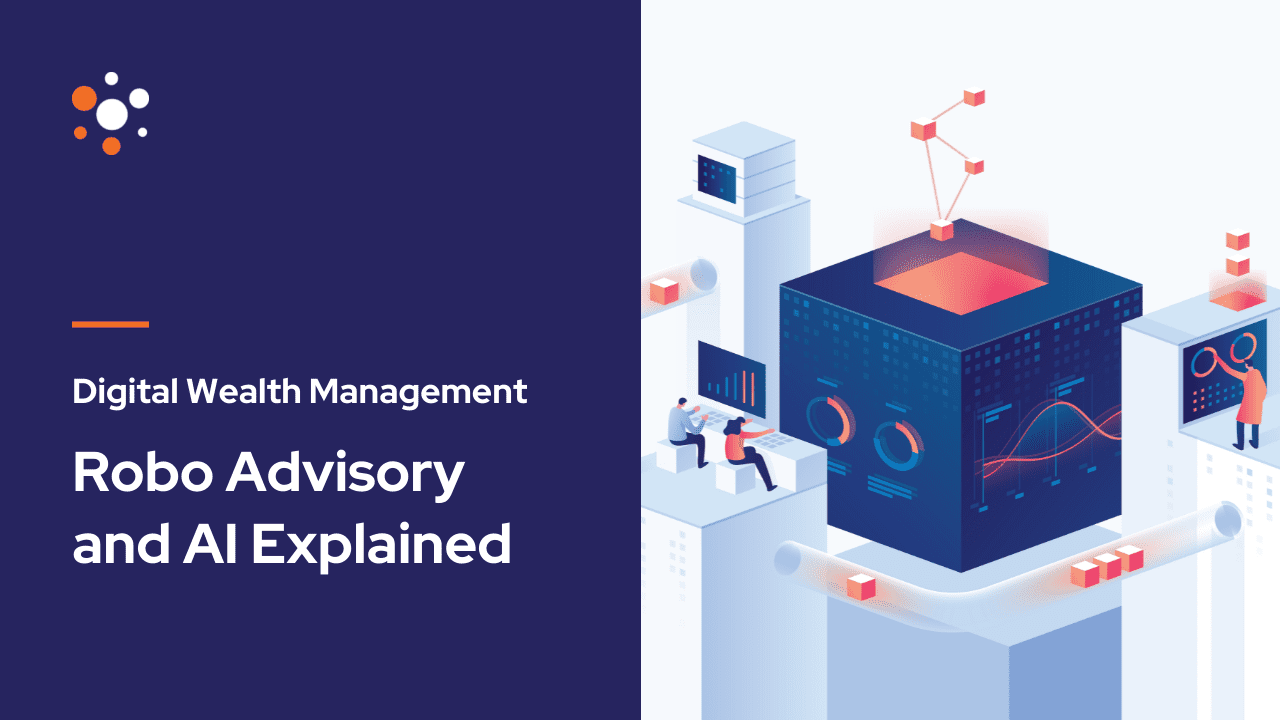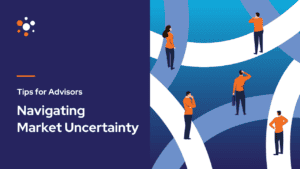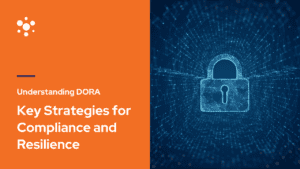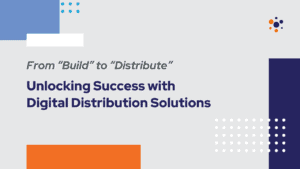Investing can be a complicated and daunting task – especially if customers are doing it on their own. Not everyone can afford an advisor or a wealth manager so it’s understandable that most people are hesitant to start investing independently. Financial institutions tend to focus on high net worth individuals when it comes to wealth management because cost per client is high.
Is there a way to take the guesswork out of investing and have someone (or something) manage portfolios for customers? Yes. That’s where robo-advisors come in.
What Is a Robo-Advisor?
Robo-advisors are digital platforms that provide automated, algorithm-driven wealth management services with little to no human supervision. A typical robo-advisor starts by asking questions about your financial situation and future goals through an online survey; it then uses the data to offer investment recommendations, advice, and then automatically invests for you. (Source)
The global robo-advisory market is expected to grow from $18.71 billion in 2021 to $28.10 billion in 2022 at a compound annual growth rate (CAGR) of 50.20%. The market is expected to reach $135.11 billion in 2026 at a CAGR of 48.08%. (Source). This growth indicates the surging popularity of such wealth services and financial institutes ought to take note.
Initial robo-advisors were made simply and functioned straightforwardly. They only had a few services to offer, and most robo-advisors stopped short at providing advice. Customers would then need to contact an advisor and begin the KYC process again before finally jumpstarting their investment journey.
However, the cutting-edge technological innovation great robo-advisors have introduced is the capability to execute a trade and automatically rebalance investor assets as the market moves. We believe it’s these trading and rebalancing capabilities that truly set them apart from the others.
Is there AI in Robo Advisory?
Contrary to its name and common industry misunderstandings, robo-advisors are not physical robots who give investment advice. They are digital applications that provide customers with financial advice based on algorithms. Sometimes these algorithms are assumed to be artificial intelligence (AI) or machine learning (ML) based, and most people use it interchangeably when they should not.
So is there AI in robo advisory? The answer is nuanced. While AI/ML will without doubt continue to evolve and be incorporated into robo advisory algorithms, the majority of robo advisory platforms are based around mathematical models. These are expressed as a set of instructions— a coded recipe—that gets evaluated and executed when triggered. This is important as it provides transparency to the end customer and financial regulators. While algorithms can be highly complex, executing instructions as if it is rational, it essentially creates automation, not intelligence.
In digital wealth management, investment constraints and limitations are written into automated decisions but these parameters still come from a human. At Quantifeed, we have a stellar team of quantitative analysts and developers who brilliantly design and orchestrate the trade order and management process, automated rebalancing, aggregation and allocation, and so much more. The process is extremely complex with little to no room for error, but Quantifeed’s strengths lie in simplifying the complex so that our partners can deliver the best wealth management experience to their customers.
Benefits of Investing with a Robo-Advisor
There are many reasons a customer would consider investing with a robo-advisor. Robo-advisors can provide guidance and assistance when it comes to investments, and they can help customers make better investment decisions overall. Here are just a few of the benefits of investing on a robo-advisor platform:
Access to Notable Investment Models
Many robo-advisors’ algorithms are based on Nobel Prize-winning investment theory to drive their models. In general, robo-advisors strive to create an investment portfolio with the greatest return for the smallest risk. Offering these types of portfolios to customers would fill a big market gap!
Saves Time
Investing can be time-consuming, especially when investors do it themselves. Robo-advisor platforms like Quantifeed’s QEngine have high quality recommendation engines that take the guesswork out of research and investment planning for the customer, simplifying a complex process.
Saves Money
Before robo-advisor platforms, professionally managed investment assistance wouldn’t be available for less than 1% of assets under management. Robo-advisors charge lower fees than traditional financial advisors, offering customers more opportunities to access high-value investment services. This helps financial institutions to reach more customers and scale their business.
Why Robo Advisors are the Way Forward
The rise of the digital age has given rise to a new breed of investor – the independent investor. These investors are comfortable making their own decisions about their wealth and don’t necessarily need or want the help of a human advisor. This is an opportunity to offer them a digital wealth management solution that can capture their interests.
Next generation investors value their time and autonomy. That’s why robo-advisory adoption is on the rise. They’re convenient. Investors can access their accounts and buy or make changes to their portfolios anytime, anywhere. The ongoing monitoring and automatic rebalancing of their portfolios also mean they can enjoy reaping the benefits of a well-balanced portfolio without constantly spending time managing it. This means there is no need to assign a human advisor, freeing up your advisor workforce’s time to build their business.
Robo-advisors are also attractive because they’re unbiased. They aren’t influenced by personal biases or emotions – they simply follow the numbers, giving investors the assurance they want and need. The last global financial crisis hit the world in 2008 and the effects of it are still felt today. It’s clear that investors would like to take their own financial future into their own hands with the help of technology.
More importantly, robo-advisory platforms are democratising wealth management. New technology in this space is giving the mass affluent segment the opportunity and access to wealth management services and advice. This also gives financial institutions an opportunity to onboard customers at an earlier stage of their wealth cycle, transition with them through the different phases of their life, and ultimately create loyalty.
The Opportunity Quantifeed Offers
So, are financial institutions and wealth managers ready to adopt the right technology that will enable them to meet the surging demand of digital wealth management? Selecting the right technology partner is crucial to ensuring a successful product.
QEngine provides end-to-end architecture and rich capability for straight-through order and trade processing, portfolio monitoring, fee management, and reporting. Its API-first development framework provides flexibility to create tailored solutions for financial institutions and can seamlessly connect with existing backend systems. Whether cloud, on-premise, or hybrid infrastructures, QEngine can be deployed anywhere and has the flexibility to adapt to evolving modernisation plans in the organisation.
Quantifeed is the leading provider of digital wealth management solutions in Asia. We have deep expertise in the region and have helped several major financial institutions to service the wealth needs of their customers. QEngine addresses the market’s desire for a simpler, personalised, and more engaging wealth management experience. Our robust trading capability and portfolio management capabilities have transformed the digital wealth management landscape in Asia.
We visited three wealth trends currently happening in the region, one of them highlighting a significant generational wealth transfer. With money bequeathed to the next generation, financial institutions must be ready to service these customers in a way that meets their expectations and preference. Robo-advisory has shown itself to be one of the next generation’s preferred methods of investing, so naturally, supply must meet the demand.
Are you interested in building a life-long relationship with your customers? Speak to us to learn more.

































